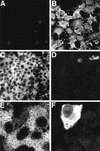Human MxA protein confers resistance to Semliki Forest virus and inhibits the amplification of a Semliki Forest virus-based replicon in the absence of viral structural proteins
- PMID: 9445055
- PMCID: PMC124633
- DOI: 10.1128/JVI.72.2.1516-1522.1998
Human MxA protein confers resistance to Semliki Forest virus and inhibits the amplification of a Semliki Forest virus-based replicon in the absence of viral structural proteins
Abstract
Mx proteins form a small family of interferon (IFN)-induced GTPases with potent antiviral activity against various negative-strand RNA viruses. To examine the antiviral spectrum of human MxA in homologous cells, we stably transfected HEp-2 cells with a plasmid directing the expression of MxA cDNA. HEp-2 cells are permissive for many viruses and are unable to express endogenous MxA in response to IFN. Experimental infection with various RNA and DNA viruses revealed that MxA-expressing HEp-2 cells were protected not only against influenza virus and vesicular stomatitis virus (VSV) but also against Semliki Forest virus (SFV), a togavirus with a single-stranded RNA genome of positive polarity. In MxA-transfected cells, viral yields were reduced up to 1,700-fold, and the degree of inhibition correlated well with the expression level of MxA. Furthermore, expression of MxA prevented the accumulation of 49S RNA and 26S RNA, indicating that SFV was inhibited early in its replication cycle. Very similar results were obtained with MxA-transfected cells of the human monocytic cell line U937. The results demonstrate that the antiviral spectrum of MxA is not restricted to negative-strand RNA viruses but also includes SFV, which contains an RNA genome of positive polarity. To test whether MxA protein exerts its inhibitory activity against SFV in the absence of viral structural proteins, we took advantage of a recombinant vector based on the SFV replicon. The vector contains only the coding sequence for the viral nonstructural proteins and the bacterial LacZ gene, which was cloned in place of the viral structural genes. Upon transfection of vector-derived recombinant RNA, expression of the beta-galactosidase reporter gene was strongly reduced in the presence of MxA. This finding indicates that viral components other than the structural proteins are the target of MxA action.
Figures







Similar articles
-
Human MxA protein protects mice lacking a functional alpha/beta interferon system against La crosse virus and other lethal viral infections.J Virol. 1999 Aug;73(8):6984-91. doi: 10.1128/JVI.73.8.6984-6991.1999. J Virol. 1999. PMID: 10400797 Free PMC article.
-
MxA-dependent inhibition of measles virus glycoprotein synthesis in a stably transfected human monocytic cell line.J Virol. 1993 Aug;67(8):4760-8. doi: 10.1128/JVI.67.8.4760-4768.1993. J Virol. 1993. PMID: 8392613 Free PMC article.
-
Inhibition of coxsackievirus B4 replication in stably transfected cells expressing human MxA protein.Virology. 2001 Apr 25;283(1):84-92. doi: 10.1006/viro.2001.0877. Virology. 2001. PMID: 11312665
-
Mx proteins: GTPases involved in the interferon-induced antiviral state.Ciba Found Symp. 1993;176:233-43; discussion 243-7. doi: 10.1002/9780470514450.ch15. Ciba Found Symp. 1993. PMID: 7507812 Review.
-
[Alpha interferon, antiviral proteins and their value in clinical medicine].Ann Biol Clin (Paris). 1999 Nov-Dec;57(6):659-66. Ann Biol Clin (Paris). 1999. PMID: 10572214 Review. French.
Cited by
-
Human MxA protein inhibits the replication of Crimean-Congo hemorrhagic fever virus.J Virol. 2004 Apr;78(8):4323-9. doi: 10.1128/jvi.78.8.4323-4329.2004. J Virol. 2004. PMID: 15047845 Free PMC article.
-
Human MxA protein protects mice lacking a functional alpha/beta interferon system against La crosse virus and other lethal viral infections.J Virol. 1999 Aug;73(8):6984-91. doi: 10.1128/JVI.73.8.6984-6991.1999. J Virol. 1999. PMID: 10400797 Free PMC article.
-
Vaccinia virus and Cowpox virus are not susceptible to the interferon-induced antiviral protein MxA.PLoS One. 2017 Jul 20;12(7):e0181459. doi: 10.1371/journal.pone.0181459. eCollection 2017. PLoS One. 2017. PMID: 28727764 Free PMC article.
-
Dengue virus induces novel changes in gene expression of human umbilical vein endothelial cells.J Virol. 2003 Nov;77(21):11822-32. doi: 10.1128/jvi.77.21.11822-11832.2003. J Virol. 2003. PMID: 14557666 Free PMC article.
-
Modelling dynamics of the type I interferon response to in vitro viral infection.J R Soc Interface. 2006 Oct 22;3(10):699-709. doi: 10.1098/rsif.2006.0136. J R Soc Interface. 2006. PMID: 16971338 Free PMC article.
References
-
- Chomczynski P, Sacchi N. Single-step method of RNA isolation by acid guanidinium thiocyanate-phenol-chloroform extraction. Anal Biochem. 1987;162:156–159. - PubMed
-
- Dreiding P, Staeheli P, Haller O. Interferon-induced protein Mx accumulates in nuclei of mouse cells expressing resistance to influenza viruses. Virology. 1985;140:192–196. - PubMed
Publication types
MeSH terms
Substances
LinkOut - more resources
Full Text Sources
Other Literature Sources

